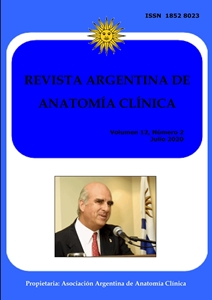CADAVERIC MEASUREMENT AND ANALYSIS OF INTERSCALENE TRIANGLE AND COSTO-CLAVICULAR SPACES IN RELATION TO THORACIC OUTLET SYNDROME
DOI:
https://doi.org/10.31051/1852.8023.v12.n2.28585Keywords:
Interscalene triangle, costoclavicular space, thoracic outlet syndromeAbstract
Objectives: Thoracic outlet syndrome (TOS) is an upper extremity disorder resulting from compression of brachial plexus structures and subclavian vessels within thoracic outlet region at any of the three primary sites- interscalene triangle, costoclavicular space and retro-pectoralis minor space. This study focused on detailed anatomic exploration and measurement of normal anatomic variability within interscalene triangle and costoclavicular space. Material and Method: We examined 49 cadavers (22 male and 27 female) and dissected both sides to explore and examine 98 dissected areas. We measured the base width, height, angle within interscalene triangle and the vertical distance within costoclavicular space. We also calculated the area of interscalene triangle. Results: The mean values of base width, height, interscalene angulation of interscalene triangle and height of costoclavular space was 10.18±4.31 mm, 45.19±0.07mm, 10.85±0.06 degrees and 10.22±0.07 mm respectively. The mean area of interscalene triangle was 214.82±5.22sqmm. Conclusion: We have found clinically significant differences between the interscalene and costiclavicular space vertical heights; the height of costoclavicular space was clinically significantly lower than the interscalene space (p< 0.001). No clinical significant difference was found between male and female measurements. These ranges of dataset could be useful for planning treatment approaches in TOS.
Downloads
References
Archie M, Rigberg D. 2017. Vascular TOS—Creating a Protocol and Sticking to It. Diagnostics. 10:7.
Cagli K,Ozcakar L, Beyazit M, Sirmali M. 2006. Thoracic outlet syndrome in an adolescent with bilateral bifid ribs. Clinical Anatomy. 19(6):558–60.
Davidovic LB, Kostic DM, Jakovljevic NS, Kuzmanovic IL, Simic TM. 2003. Vascular thoracic outlet syndrome. World Journal of Surgery. 27 (5):545–50.
Degeorges R, Reynaud C, Becquemin JP. 2004. Thoracic outlet syndrome surgery: longterm functional results. Annals of Vascular Surgery. 18(5):558–65.
Demondion X, Boutry N, Drizenko A, Paul C, Francke J, Cotton A. 2000. Thoracic outlet: anatomic correlation with MR imaging. Am J Roenterol., 175:417-22.
Demondion X, Bacqueville E, Paul C, Duquesnoy B, Hachulla E, Cotton A. 2003.Thoracic outlet: assessment with MR imaging in asymptomatic and symptomatic populations. Radiology. 227 (2):461–8.
Demondion X, Herbinet P, Van S, Boutry N, Chantelot C, Cotton A. 2006. Imaging assessment of thoracic outlet syndrome. Radiographics. 26:1735–50.
Dahlstrom KA, Olinger AB.2012. Descriptive anatomy of the interscalene triangle and the costoclavicular space and their relationship to thoracic outlet syndrome: a study of 60 cadavers. J Manipulative Physiol Ther. 35 (5):396-401.
Gockel M, Vastamaki M, Alaranta H.1994. Long-term results of primary scalenotomy in the treatment of thoracic outlet syndrome. Journal of Hand Surgery [Br]. 19(2):229–33.
Gliedt JA, Clinton JD, Enix ED. 2013. Clinical Brief: Neurogenic Thoracic Outlet Syndrome
Topics in Integrative Health Care. 4(3).
Hooper TL, Denton J, McGalliard MK, Brismée JM, Sizer PS Jr.2010. Thoracic outlet syndrome: a controversial clinical condition. Part 1: anatomy and clinical examination/diagnosis. J Man Manip Ther. 18(2):74–83.
Jordan A, Gliedt DC, Clinton J, Daniels DC, Dennis E, Enix DC. 2013. Clinical Brief: Neurogenic Thoracic Outlet Syndrome. Topics in Integrative Health Care. 4(3).
Kaplan T, Comert A, Esmer AF, Atac GK, Acar HI, Ozkurt B. 2018.The importance of costoclavicular space on possible compression of the subclavian artery in the thoracic outlet region: a radio-anatomical study. Interact CardioVasc Thorac Surg. 27:561–5.
Levine N, Rigby BR. 2018.Thoracic Outlet Syndrome: Biomechanical and Exercise Considerations Healthcare (Basel). 6(2): 68.
Mackinnon SE, Novak CB.2002.Thoracic Outlet Syndrome. Curr. Probl. Surg. 39: 1070–1145.
Roos DB. 1976. Congenital anomalies associated with thoracic outlet syndrome. Anatomy, symptoms, diagnosis and treatment. Am J Surg. 132:771-8.
Remy JM, Remy J, Masson P, Bonnel F, Debatselier P, Vinckier L.2000. Helical CT angiography of thoracic outlet syndrome. Am J Roent. 174:1667-74.
Sheth RN, Belzberg AJ.2001. Diagnosis and treatment of thoracic outlet syndrome. Neurosurg Clin N Am. 12(2):295-309.
Savgaonkar MG. Chimmalgi M, Kulkarni UK. 2006. Anatomy of inter-scalene triangle and its role in thoracic outlet syndrome. J Anat Soc India. 55:52-5.
Sanders RJ, Hammond SL, Rao NM. 2007. Diagnosis of Thoracic Outlet Syndrome. J. Vasc. Surg., 46:601–604.
Urschel JD, Hameed SM, Grewal RP. 1994. Neurogenic Thoracic Outlet Syndromes. Postgrad. Med. J. 70:785–789.
Urschel CH. 2005. Transaxillary First Rib Resection for Thoracic Outlet Syndrome. Operative Techniques in Thoracic and Cardiovascular Surgery. 10(4):313-317.
Van Es HW. 2001. MRI of the brachial plexus. European Radiology.11(2):325–36.
Watson LA, Pizzari T, Balster S. 2009.Thoracic outlet syndrome part 1 Clinical manifestations, differentiation and treatment pathways Manual Therapy.14:586–595.
Downloads
Published
How to Cite
Issue
Section
License
Copyright (c) 2020 Subhramoy Chaudhury, Anasuya Ghosh

This work is licensed under a Creative Commons Attribution-NonCommercial 4.0 International License.
Authors retain copyright and grant the journal right of first publication with the work simultaneously licensed under a Creative Commons Attribution License that allows others to share the work with an acknowledgement of the work's authorship and initial publication in this journal. Use restricted to non commercial purposes.
Once the manuscript has been accepted for publications, authors will sign a Copyright Transfer Agreement to let the “Asociación Argentina de Anatomía Clínica” (Argentine Association of Clinical Anatomy) to edit, publish and disseminate the contribution.



